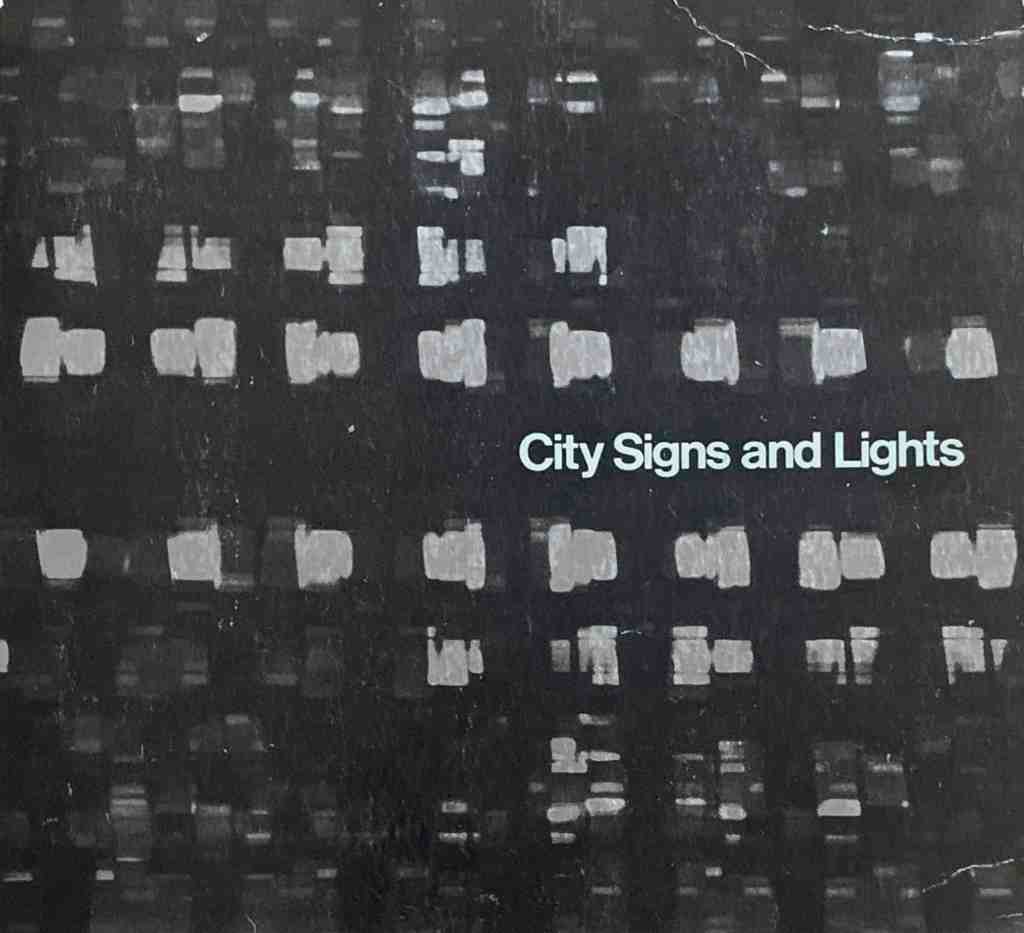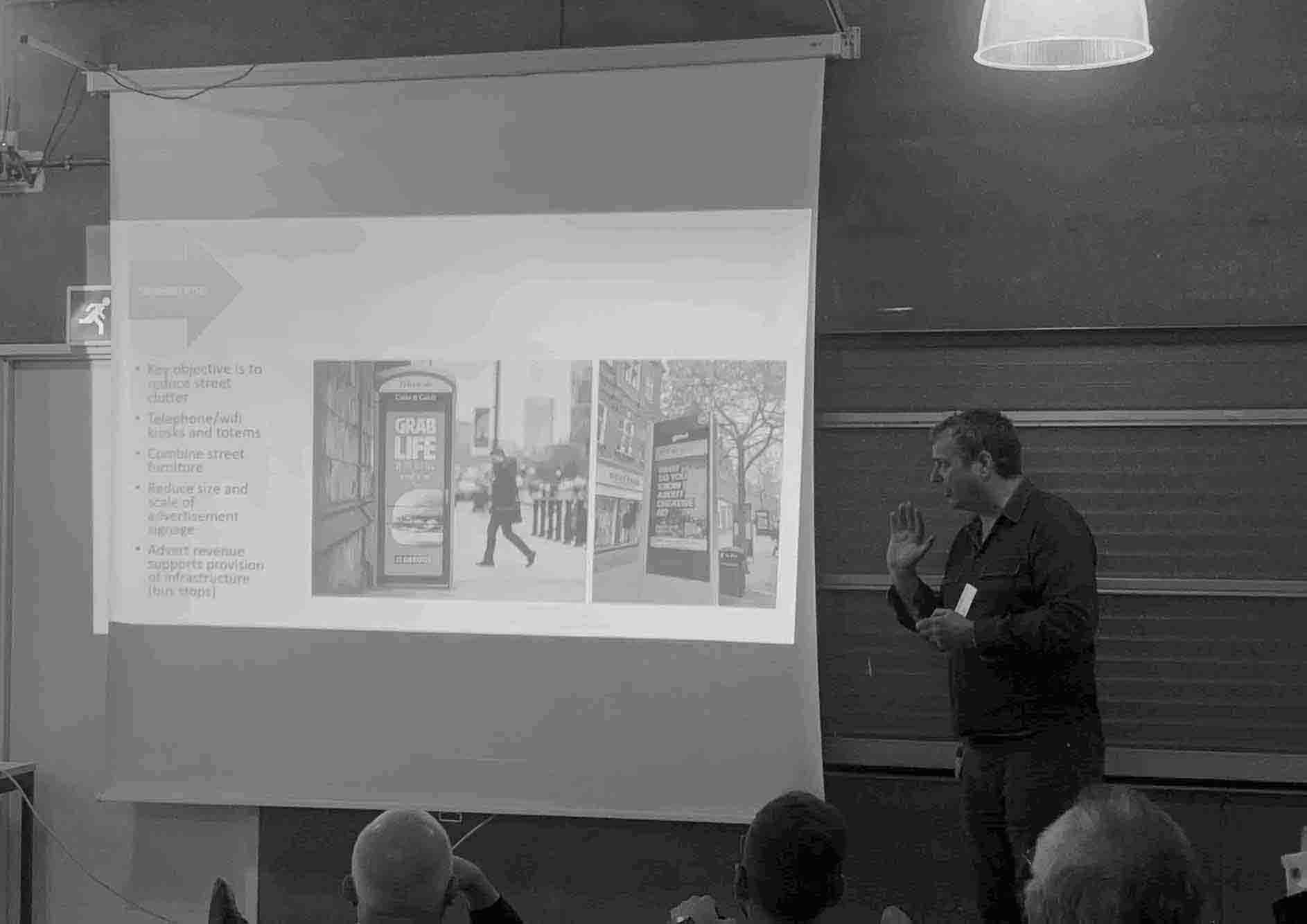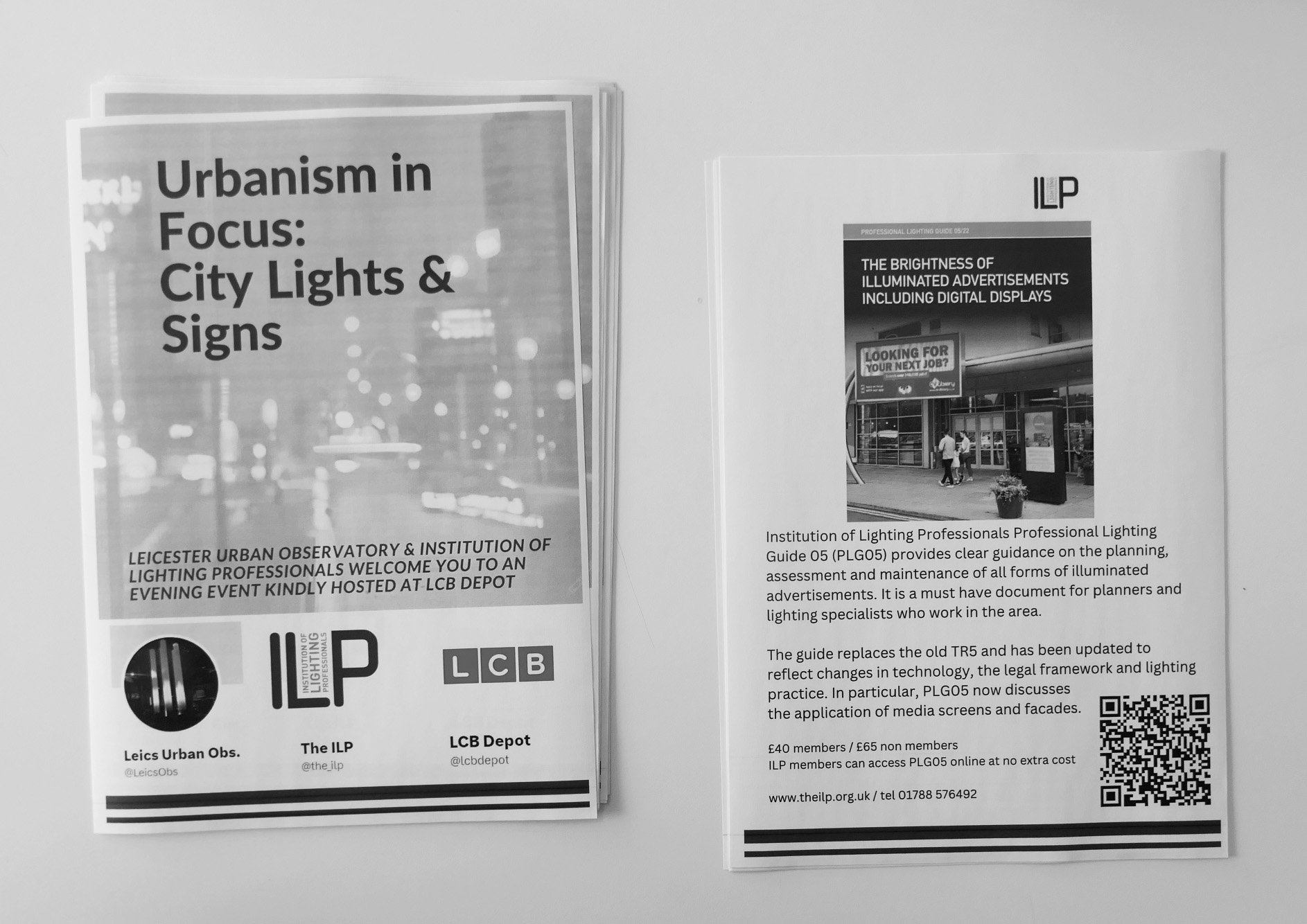This event was inspired by Stephen Carr’s publication ‘City Signs and Lights: A Policy Study’ prepared for the Boston Redevelopment Authority and the U.S. Department of Housing and Urban Development (published in 1973 by The MIT Press).
It was the result of ongoing discussions over several years about the urban communication function of street lighting between Robert Harland and Nic Winter, a road, street, and tunnel lighting specialist at Thorn Lighting. These were further enhanced through conversation with Jess Gallacher, then Knowledge Transfer and Communications Manager at the Institute of Lighting Professionals (ILP).
Together, the ILP with Leicester Urban Observatory and LCB Depot hosted 20 people from the lighting industry, local councils, historical societies, and universities in Leicester and Loughborough.

Above: City Signs and Lights: A Policy Study by Stephen Carr, The MIT Press (1973). Photograph of author’s copy.
Event Review
Creating a More ‘Legible’ Public Realm, Lighting Journal, July/August 2023, pp. 24–26. Full text reproduced below with permission.
Creating a More ‘Legible’ Public Realm
A recent Institute of Lighting Professionals (ILP) event brought together academics and lighting professionals to consider how public realm lighting can be better integrated into – and even lead – urban design and placemaking.
By Graham Festenstein
Earlier this year, the Institute of Lighting Professionals (ILP) collaborated with the Leicester Urban Observatory on the first of a series of events to discuss the lighting of public space from a planning perspective, with an emphasis on the integration of lighting with signage and wayfinding, along with the potential for public art to play a role in urban design and placemaking.
The Leicester Urban Observatory is a collaboration between urban practitioners at Leicester City Council and academics at three local universities: De Montfort, Leicester, and Loughborough. It aims to establish and develop a combined centre of excellence in urban studies and planning for Leicester. Three speakers took part in the event: Grant Butterworth, head of planning for Leicester City Council; Dr Sean Clark, a digital and multimedia artist who has an interest in community projects and illuminated work; and myself on behalf of the ILP (as I am a lighting designer and consultant specialising in urban lighting).
The evening was introduced by Dr Robert Harland, […] Reader in Urban Graphic Heritage at Loughborough University. We were joined for discussion by an audience of lighting professionals, planners and architects.
Lighting to Support Placemaking
The importance and potential of lighting to support placemaking and wayfinding within the public realm is often overlooked, with an over-reliance on street lighting to comply with standards and a design brief. This, in turn, too often precludes proper integration with landscape, architectural design and way-finding strategies.
The ILP as an Institution promotes collaboration between designers, engineers and other consultants involved with public realm design to ensure all users of public space are served, so creating comfortable, legible and safe places that are easily navigated.
Traditionally, the dialogue between lighting designers and planners has been fairly limited, leading to priorities that often do not do justice to the life and community that goes on during the hours of darkness, darkness that in the winter can of course begin as early as 4:00 pm in the afternoon.
Lighting is often seen as a technical engineering exercise executed at the end of a project rather than one integral to the design from the start as it should be. The way a space looks, feels and performs at night is fundamental to success of our urban communities.
The purpose of this and the further events to follow is to bring together lighting designers and engineers with planners and the other disciplines involved in public realm design to better understand how lighting can be supported and strategies developed to achieve these aims.
Lighting for Visual Amenity
Grant Butterworth started the evening with a discussion around the planning priorities for lighting for visual amenity, protection of the environment and ecology through sensitive and properly considered lighting and the economic benefits of lighting through marketing, tourism and business promotion.
He went on to consider the social benefits of lighting, community safety and the promotion of heritage, architecture and cultural engagement through community events and cultural festivals such as Diwali, which of course is especially pertinent in Leicester, and how all of these areas of discussion are interlinked and the role of the local authority in delivering and managing them.
Grant used examples of Leicester’s architectural feature-lighting grant scheme to illustrate some of his points along with images of lighting in public spaces. These included examples of poor lighting, in particular some digital displays demonstrating the potential harm that can be done through bad lighting and when it is not regulated properly through the planning process.
Grant’s concluding statements can be summed up as follows: ‘Lighting can generate and reveal beauty… It can be a valuable and valued community resource. It can protect… It can harm and annoy… So it does need to be managed. Understanding the design process from all technical disciplines is a key objective.’

Grant Butterworth sets out the challenges associated with street advertising and illumination.
Lighting and Festivals
Sean’s presentation, meanwhile, discussed a number of public art installations and installations for cultural festivals he has produced, many involving an element of community engagement and or interactivity.
In particular, he discussed his involvement in the Light up Leicester light festival. Sean’s work is interested in using technology to explore connectedness, often in a simple yet innovative way and light, lights or illuminated elements figure prominently in much of his work.
When working in the public realm, he explained, he is interested in how his lit installations, or the way people interact with his installations, respond to the space or environment they are located within. For example, how they may be connected or lead people across the city or react to specific locations.
Sean outlined how he is very keen to explore the use of technology on a city-wide basis to create city-wide installations that connect people and places across the pubic realm. As he explained, in his artwork, he is inspired by systems’ theory, the nature of interactivity and creative explorations of flow, connectedness and communication.
Lighting and Urban Space
Finally, for my own presentation, I discussed the role of lighting in placemaking and creating what I termed as a ‘legible’ public realm at night.
In particular, my discussion brought together a number of themes from the other presentations to demonstrate how lighting can be better integrated with urban design. In essence, how using elements of architectural or landscape feature lighting, street and area lighting, public art and lighting for wayfinding can deliver public spaces that are more comfortable and easier to understand.
How, too, lighting can be used to make spaces more navigable, using visual cues to orientate and create destinations that promote footfall and permeability.
My presentation highlighted the importance of vertical illuminance on building façades or other structures, either through controlled light spill or with designed architectural lighting; how this, again, helps legibility and how, without it, the sense of a space can be dissipated.
To my mind, an urban space is often defined by the buildings that surround it and, if this is lost, the character and identity at night can be lost. Lighting can benefit the night-time economy and can bring social benefits, so potentially reducing anti-social behaviour and promoting sustainability through community living.
I believe there is clear potential to develop design integration further through the use of lighting controls and smart city technologies. We need to be developing better strategies for urban lighting and using lighting masterplanning to draw together all of the threads discussed by all three speakers to create, ultimately, a much more cohesive approach to the design of public spaces at night.
The evening was then rounded off by a discussion with the audience that demonstrated the need to dig deeper into the interesting topics and differing perspectives raised. I certainly look forward to exploring these questions further as the collaboration between ILP and the Leicester Urban Observatory develops over the coming months.
But let me leave the final word to Robert Harland. The event, he argued, was a first for the Leicester Urban Observatory. ‘Conceiving the idea and making it happen with the ILP set in place not only the opportunity to hear from highly specialised lighting professionals and practitioners, spanning planning, design, and arts, but the event also provided a template for future events of this kind,’ he said.
These may involve other professionals who contribute to the way people and places interface. The academic underpinning of Stephen Carr’s City Signs and Lights policy study from Boston in the early 1970s underpinned the talks, and emphasised importance of lighting as a communication tool in cities,’ Robert added [1].
Graham Festenstein CEng FILP FSLL runs Graham Festenstein Lighting Design and is the ILP’s Vice President – Architectural

Event publicity and publications from ILP.
Reference
[1] City Signs and Lights, Stephen Carr, 1973, https://www.goodreads.com/book/show/81760.City_Signs_and_Lights